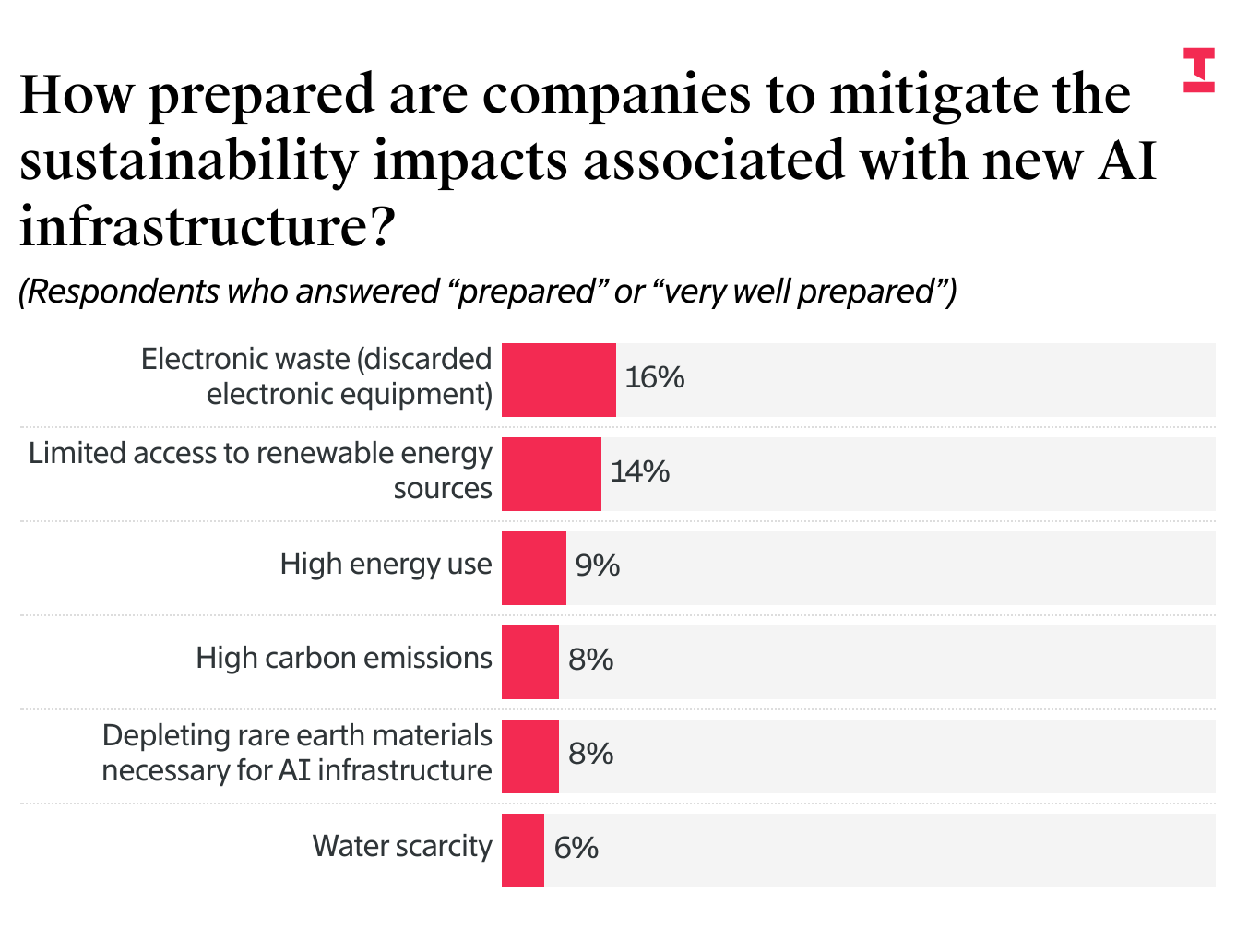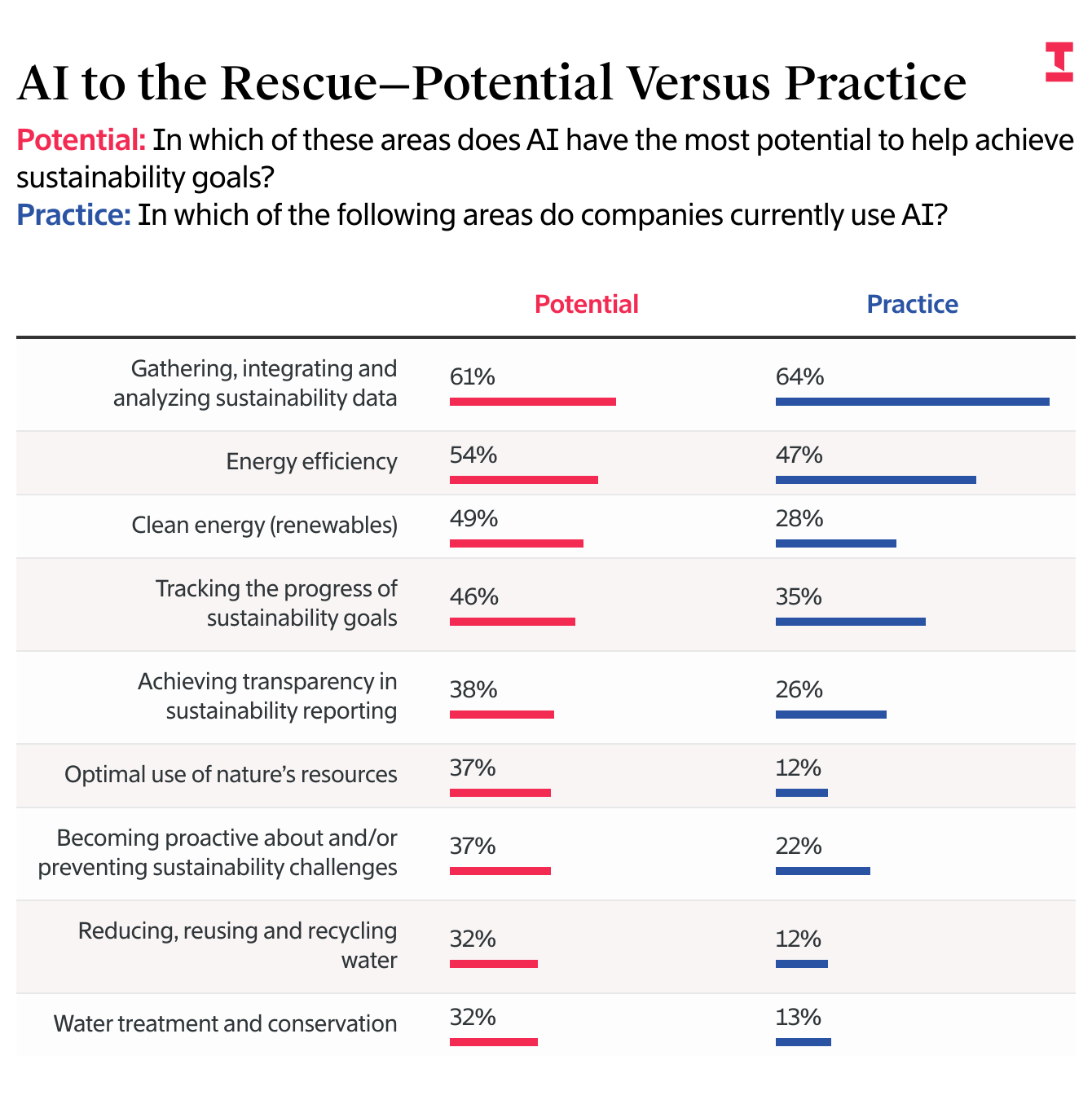The Most Overlooked Constraint on AI

By 2030, fresh water demand is projected to outstrip the global water supply by nearly 56%, according to the World Resources Institute. At the same time, the growing development of artificial intelligence infrastructure—which depends on water for cooling systems and throughout its energy supply chain—is projected to consume 1.1 trillion to 1.7 trillion gallons of freshwater annually, roughly equivalent to the yearly water use of all households in California.
And yet, The Information’s survey of more than 100 readers on their view of data centers and environmental topics finds that water scarcity is a largely unrecognized risk, and few companies are prepared to handle it. One reader points to that omission, saying that “water use is more important than energy sourcing.”
Other key findings of the survey include:
Awareness. AI infrastructure’s impact on water is perceived as far less than other environmental impacts. Thirty-seven percent of survey respondents believe that AI development impacts water scarcity, compared to 52% who see the impact of carbon emissions and 50% who cite the depletion of rare earth materials.
Preparedness. Of these stressors, companies are least prepared to address water scarcity. Just 6% of the survey respondents believe that businesses will be able to address water stress, compared to 16% who believe they are ready to address electronic waste and 14% who are prepared to cope with limited access to renewable energy sources.
The AI paradox. AI can add to demand for resources, but it can also be part of the solution to inefficiency. There is potential to use AI to mitigate water scarcity, yet much of this potential is unrecognized and unrealized. For example, while 32% of the survey respondents recognize the potential of AI for reducing, reusing and recycling water, only 12% are currently using AI solutions to do so.
Environmental Impacts: Awareness
Most of The Information’s survey respondents recognize that the development of AI infrastructure is placing increased demand on natural resources, with majorities recognizing high energy use (71%), high carbon emissions (52%) and depletion of rare earth materials (50%). But only 37% identify water scarcity as a key impact area (see chart).

Why doesn’t water, which is critical for the functioning of AI infrastructure, figure more prominently in the minds of executives developing data centers?
With most data centers using water for cooling, global AI demand is estimated to consume 1.1 trillion to 1.7 trillion gallons of freshwater annually by 2027. That rivals the amount of water all households in California use in a year, and it’s rising faster than water usage in any single sector outside agriculture. One study found that generative AI consumes about one bottle of water for every conversation users have with it.
A recent report from Bloomberg shows that AI data centers in the U.S. are placing increasing strain on water security. The report found that close to two-thirds of new data centers constructed or in development since 2022 have been in locations with high levels of water stress. This is because data centers must be built close to the population they serve, so populated cities like Phoenix or Dallas need AI infrastructure—even if they are experiencing water stress.
At the same time, experts warn that global freshwater demand will exceed supply by 56% by 2030. This puts an onus on companies building data centers to measure water risk, reduce usage and recycle water.
Environmental Impacts: Preparedness
While survey respondents agree that the development of AI infrastructure comes with environmental impacts, just 11% think that AI infrastructure companies successfully address these impacts, compared to successfully handling operational (44%) and financial (32%) impacts.
“For now, it’s a race to win. Thoughts about the environment are not a big priority,” says one of The Information’s readers. “It’s hard to balance [business and environmental outcomes], and the main issue is that only a very select few even seem to be trying,” says another reader.
The Information’s survey reveals that few companies are poised to maximize sustainability while developing AI infrastructure in the near term. Water scarcity is what companies are the least prepared for, with just 6% of the survey respondents believing that businesses are prepared to address the issue.

“We believe the future isn’t about choosing between growth and sustainability—it’s about making them mutually reinforcing,” said Emilio Tenuta, senior vice president and chief sustainability officer, Ecolab. “The companies that will lead in the AI era are those that embed environmental stewardship into their business models.”
In the end, the drive to achieve preparedness for protecting water may boil down to business and financial indicators—and recognizing that business performance and natural resource stewardship can go hand-in-hand.
Environmental Impacts: Action
A significant number of data centers are taking actions to alleviate their environmental impact by applying energy efficiency solutions (61%) and utilizing renewable energy sources (53%) (see chart).

“At Ecolab, we work with high-tech leaders to make sustainability a lever for growth—not a constraint,” Tenuta said. “Our solutions combine advanced chemistry, digital intelligence and deep operational expertise to help customers address water and energy use, minimize emissions and improve system performance. It’s about scaling smarter, not just bigger.”
Forty-four percent of the survey respondents believe that data centers are utilizing advanced water treatment and cooling management systems, and 13% think that they are utilizing biodegradable and nontoxic chemicals for water treatment. Among some of the water solutions for data centers are real-time monitoring and analytics to optimize water use and detect inefficiencies, water reuse systems and programs balancing uptime with water conservation.
“The value of real-time monitoring is in what it prevents—and what it unlocks,” Tenuta said. “By tracking system health continuously, operators can catch issues before they escalate, preserving uptime and extending the life of critical assets.”
The paradox of AI is that while it is the source of the environmental issues, it can also be a tool for solving them. Says one of The Information’s readers: “AI is the only tool that can keep pace with its own rate of change. Use AI to mitigate the impact of AI using self-evolution feedback looping.”
Thirty-eight percent of The Information’s readers believe that new AI technology presents brand-new solutions for addressing the natural resource demand associated with AI infrastructure. But that realization is not converted into action often enough: Just 17% say that the AI technology sector has focused on developing AI-driven solutions to advance sustainability.
That unrealized potential is depicted in the chart showing how The Information’s readers view the potential of AI to help achieve sustainability goals compared to where companies are already using AI to this end. In many cases, practice significantly lags potential in terms of applying AI to sustainability goals.

Some of the biggest gaps between the potential of AI and how it’s currently used to mitigate environmental impacts are related to water, including reducing, reusing and recycling water (a 20 percentage point difference) and water treatment and conservation (a 19 percentage point difference).
One area where companies are using AI to reach its potential is gathering, integrating and analyzing sustainability data. AI’s ability to make sense of reams of data quickly is why the data-driven approach sits right on top.
One reader is optimistic about the potential of AI to secure its own positive environmental legacy: “As new foundation models gain ever stronger agentic capabilities, they will exponentially accelerate our ability to carry out engineering and scientific research. This will have a massive impact on reducing and possibly eliminating environmental impact.”
CONCLUSION
There is significant room for improvement in how the technology industry handles the environmental risks associated with developing AI infrastructure. At this stage, just 15% of The Information readers believe that global high-tech companies have achieved a best-in-class approach to the energy and water demands of AI infrastructure.
The potential for a turnaround is there. Most of the survey respondents (65%) believe that if the technology industry can leverage AI to address the challenges associated with AI, AI infrastructure developers could emerge as innovative solvers of key environmental problems.
To achieve that, they need to place greater focus on environmental risks, especially those that seem to be overlooked, like water scarcity. They will also have to pursue sustainability alongside business performance and improve their preparedness. That in turn can happen if they apply the power of AI to solve for sustainability and help build resilience and prosperity—even in a resource-constrained world.
Methodology
This report is based on a survey of 115 of The Information’s readers conducted in May 2025. Survey respondents represented different company sizes, industries, functional areas and titles. Specifically:
Company size: Forty-six percent of respondents came from companies with revenues under $10 million; 15% had revenues between $10 million and $100 million; 14%, between $100 and $1 billion; 7%, between $1 billion and $5 billion; and 18% had revenues of $5 billion or more.
Industry: The top four industries represented in the survey were technology; media and telecommunications (43%); financial services and capital markets (11%); and professional services (10%). The remaining industries, all under 10%, were healthcare and life sciences; government and public sector; consumer; retail and e-commerce; hospitality, food, leisure and travel; and industrial manufacturing.
Functional area: Respondents represented multiple functional areas, with the biggest groups coming from general management (23%); research and development (12%); sales (11%); information technology (10%); and engineering (10%). The remaining areas, all under 10%, were finance; marketing and communications; legal; manufacturing and operations; and human resources.
Title: Respondents had a variety of titles, with the biggest groups being directors (18%); chief technology and chief information officers (17%); managers (14%); and CEOs (11%). Other titles, each under 10%, were owners; CEO-owners; senior vice presidents and vice presidents; chief marketing and communications officers; chief operations officers; chief financial officers; chief counsel; chief revenue officers; and chief human resources officers.